Meal 95: Lesotho
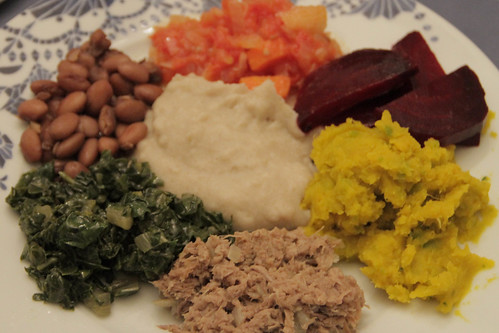 I didn't plan it this way or expect it to happen, but my gosh, what a pretty meal Lesotho offered. All these portions with different colors and textures look almost like an artist's palette. The dishes are quite plain, with such simple preparation that many barely have a recipe, but in combination there's lots of variety. It also happens to be quite healthy! This meal is definitely representative of summertime, when more food can be eked out of the meager, mountainous soil.
I didn't plan it this way or expect it to happen, but my gosh, what a pretty meal Lesotho offered. All these portions with different colors and textures look almost like an artist's palette. The dishes are quite plain, with such simple preparation that many barely have a recipe, but in combination there's lots of variety. It also happens to be quite healthy! This meal is definitely representative of summertime, when more food can be eked out of the meager, mountainous soil.

This was our first Nosh after getting press on NPR and our local OPB, and one of the many people who reached out to us was Erin, who did Peace Corps in this little country surrounded by South Africa. Between her fellow volunteer Anne and others who've blogged about their eating experience there, I was able to piece together a decent idea of what to serve. To be clear, this is far more variety than most people in Lesotho eat most days, but the intention is always to go a step up to what would be at a celebration or a feast.
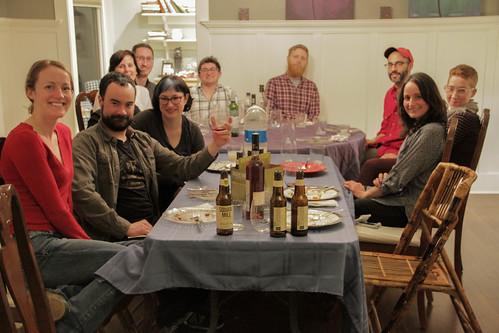
Our guests were Levi, Julie, another Julie, Greg, Matt, Will, Annie, Lauren, Will, and of course Erin, who told some fascinating stories, including the habit of hiking to hilltops for cell reception!
Motoho | Sour sorghum porridge

I read that Basotho (that's the name for the people of Lesotho) have a taste for fermented and tangy things, so I wanted to give this a shot. I figured I'd make a batch of this and then we'd move onto pap, the more typical cornflour-based porridge that's the true foundation of Basotho cuisine, but one batch of the sorghum got us through the meal!
As with most soured foods, the way you make it is by putting a bit of the previous batch in the new batch so the bacteria and yeast can grow, but of course I don't know anyone with motoho at the ready, so I did the next best thing and dropped in some of my own sourdough starter which is typically intended for breads with wheat flour, and mixed in enough water for a stiff dough. (You can also leave it out for a few days and hope it sours right, but that method is unpredictable and I couldn't take the risk.) After an overnight in an oven gently heated by the warming drawer, this dough had the unmistakable, slightly sweet and definitely sour whiff of fermentation gone right. Add more water, simmer and stir, done.
I found this surprisingly tasty, definitely more palatable than the fermented cornflour we'd tried once or twice for West African countries. And it was thick enough to pick off a piece with your hand in the traditional way.
Morogo | Greens
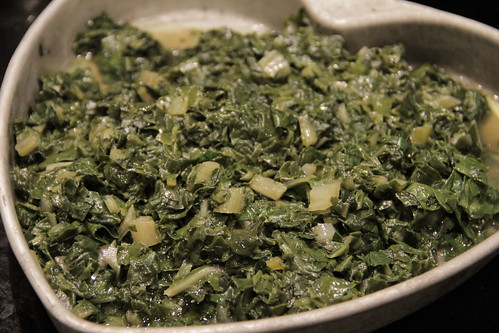
Anne's recipe for greens is pretty simple:
Tamati | Tomato-carrot stew
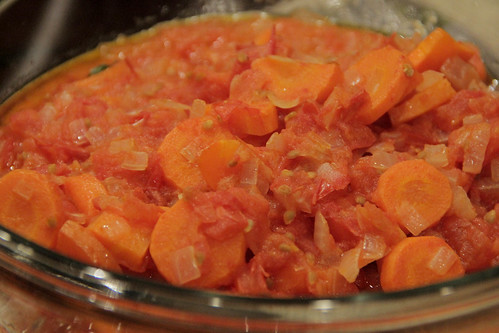
With three ingredients (plus oil and salt), this was just about the most complicated dish, and even then it's pretty simple. Anne again:
-Heat some oil in a pan -Add quite a bit of diced onion and saute until translucent -Add chopped carrots and cook/stir for a few minutes -Add lots of diced tomato -Let simmer as long as you want and add salt to taste (this recipe is not an exact science, just follow your gut re: proportions. It should end up thick-sauce consistency. In a lot of villages, they make this without the carrots, but I think it is a lot tastier with...).
For being such simple vegetables and nothing more than salt, somehow this came out really tasty. I credit the carrots.
Dinawa | Beans
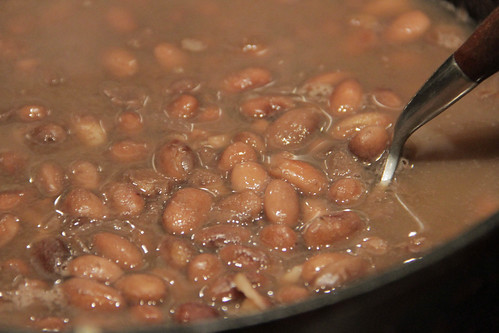
Nothing more than pink beans (which I found at a Mexican market) simmered for a long time with a bouillon cube. I told you this was a pretty healthy cuisine!
Lekhotloane | Bashed beef | Recipe
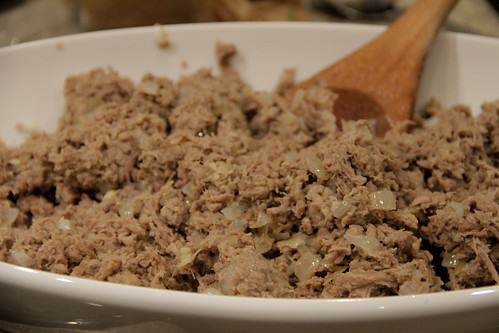
Beef is a special food, apparently rather less common than chicken, but I couldn't find a distinctively Basotho chicken recipe but I did for beef. It sounds unpleasant to describe a brisket that's boiled for a long time before being bashed in a large mortar and pestle, but that's exactly what this was and it was delicious.
Mokopu | Pumpkin
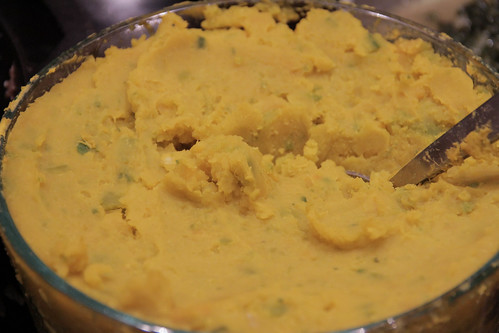
Kabocha squash, boiled, mashed, with salt. Can it get simpler?
Bete | Beets
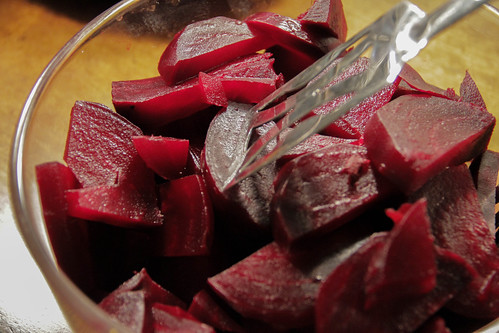
Yes! Even simpler! One ingredient only: beets, boiled, cooled until I could peel them, then sliced. A big boost to the color-wheel, and no seasoning needed since several other dishes were pretty salty.
Gemere | Ginger beer | Recipe
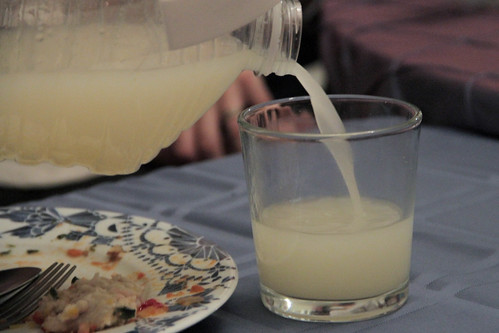
If you've ever wanted to experiment with home brewing, ginger beer is absolutely the easiest way to start. It may seem like a lot of steps, but it's all very easy and forgiving; so long as you have a large vessel and some plastic bottles, you're in business. (Of course, you need other stuff like ginger.) You end up with a very mildly alcoholic brew, and the unique satisfaction of tasting effervescence on your tongue that you made happen by mixing yeast and sugar and sealing it off. Goes great with gin, by the way.
Jello trifle | Recipe 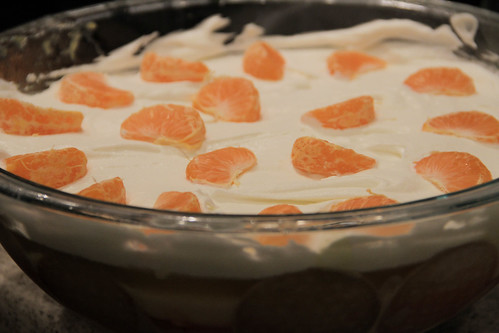
One Peace Corps blogger mentioned a curious dessert that combines Jello and custard with cookies for good measure, and that was just too wonderfully weird to pass up. Indeed, I found a recipe in a Mormon newsletter from the '70s of just this sort of dish from neighboring South Africa, so voila. Without any guidance on the flavors I went with lemon and strawberry gelatins. It wasn't half bad, though the soaked cookies were a bit disconcerting. I'll keep this recipe in my back pocket in case I need to go to a "Midwest in the '70s" potluck or the like.